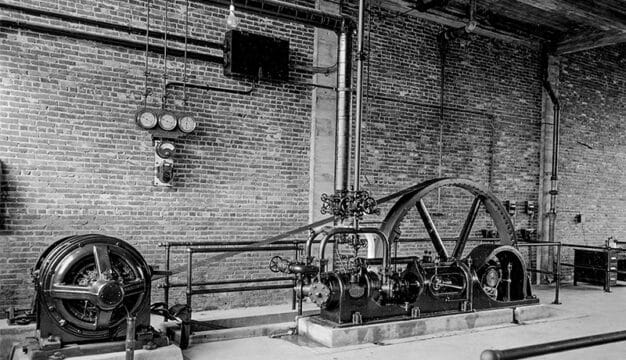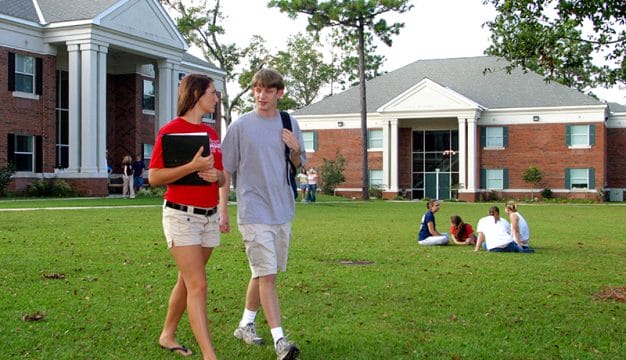Miles College
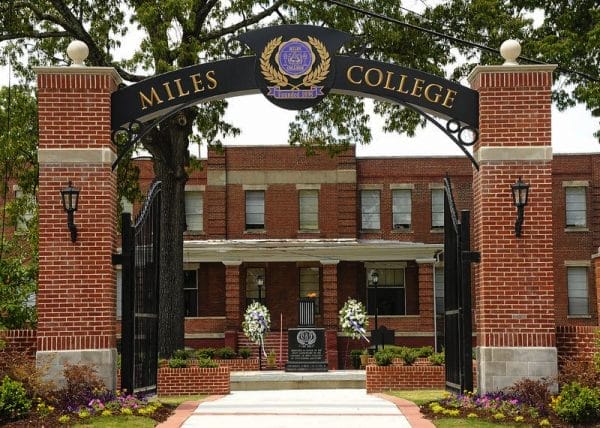 Miles College
Miles College, located in Fairfield, Jefferson County, was founded by the Colored Methodist Episcopal Church, now the Christian Methodist Episcopal Church (CME) as Miles Memorial College in 1896. It is one of several historically black colleges and universities (HBCUs) in the state with a primary mission to provide a liberal arts and faith-based education to African Americans.
Miles College
Miles College, located in Fairfield, Jefferson County, was founded by the Colored Methodist Episcopal Church, now the Christian Methodist Episcopal Church (CME) as Miles Memorial College in 1896. It is one of several historically black colleges and universities (HBCUs) in the state with a primary mission to provide a liberal arts and faith-based education to African Americans.
The college is named after CME bishop William H. Miles, who was born into slavery in 1828 in Springfield, Kentucky. Later freed, although sources disagree on when, Miles joined the Methodist Episcopal Church (South) and became a preacher in 1857. At the conclusion of the Civil War, Miles joined the newly established CME Church and was eventually elected bishop in 1870. He saw the church as an expression of black freedom and self-governance. Under his 22 years of leadership, the CME Church grew into one of the largest in the South serving freed slaves. His leadership and views of on black self-determination led the CME Church to name the Alabama college after him.
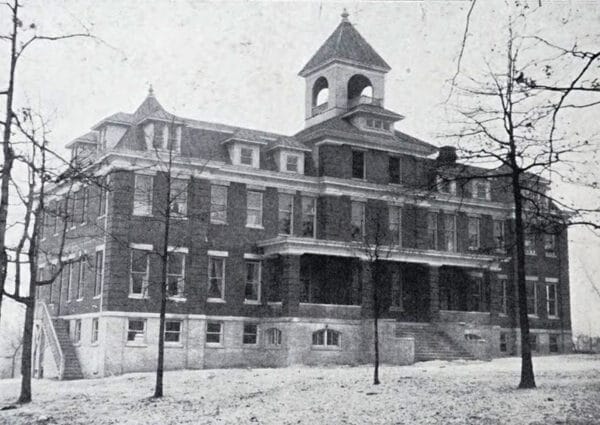 Miles Memorial College
The CME Church created Miles College by consolidating its high schools in Booker City (present-day Docena) and Thomasville. The co-educational college was chartered by the state of Alabama and formed its board of trustees in 1905. Like many black colleges, Miles initially provided instruction for primary and secondary school students. By 1907, the first president, James A. Bray (1907-1912), oversaw the introduction of a college curriculum that included mathematics, rhetoric, literature, Latin, Greek, psychology, and history. The high school curriculum continued at Miles for many years thereafter, however. In 1912, Miles professor William A. Bell assumed the presidency for one year.
Miles Memorial College
The CME Church created Miles College by consolidating its high schools in Booker City (present-day Docena) and Thomasville. The co-educational college was chartered by the state of Alabama and formed its board of trustees in 1905. Like many black colleges, Miles initially provided instruction for primary and secondary school students. By 1907, the first president, James A. Bray (1907-1912), oversaw the introduction of a college curriculum that included mathematics, rhetoric, literature, Latin, Greek, psychology, and history. The high school curriculum continued at Miles for many years thereafter, however. In 1912, Miles professor William A. Bell assumed the presidency for one year.
Miles College grew both physically and in terms of curriculum in the years following World War I. Pres. Mack P. Burley initiated both of these expansions in 1926 with the aid of the General Education Board of New York, the Federal Works Progress Administration, and both the CME and Methodist Episcopal (South) churches. During this period, the college continued to provide primary and secondary instruction while expanding the teacher education programs and the classical liberal arts curriculum. This was a noteworthy strategy, as many black colleges at the time were choosing to follow Tuskegee Institute‘s lead in promoting vocational education only.
The Great Depression slowed the expansion of the college’s curriculum. Enrollments were at a height of nearly 575 in the mid-1920s and fell to 330 in 1934, just a few years after Brooks Dickens (1931-36) took office as president. Dickens was able to restore the college to financial health, in part, because of a gift from the John F. Slater Fund, which allowed Miles College to continue paying its faculty. In 1936, William A. Bell (1936-61) resumed the presidency and continued to raise funds for the college. In 1941, the school name was shortened to Miles College and by 1948 enrollment had increased to more than 1,200 students.
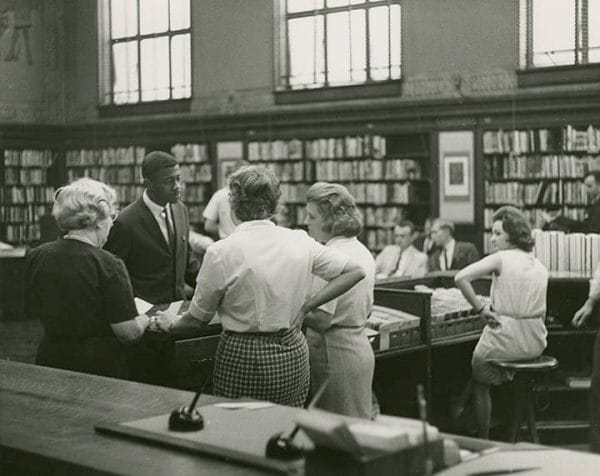 Desegregation of Birmingham Public Library
As occurred at many black colleges in the 1960s, Miles students, faculty, and staff were active in the civil rights movement. Throughout the era, the college and specifically Pres. Lucius Pitts (1961-71) supported Miles students’ participation in non-violent protests. In February 1962, for instance, Pitts tried to ease race relations with white citizens of Birmingham. He organized meetings among students, merchants, and members of the community in the hope of forestalling a threat of boycotts led by Miles students. Some stores responded by integrating water fountains and an elevator, but full integration was rejected. As a result of these half measures from the white merchants, Miles students began a boycott of area businesses called the “Selective Buying Campaign” in March 1962. Although that campaign did not directly achieve its goals, these and later actions by the school community set in motion the end of segregation in Birmingham.
Desegregation of Birmingham Public Library
As occurred at many black colleges in the 1960s, Miles students, faculty, and staff were active in the civil rights movement. Throughout the era, the college and specifically Pres. Lucius Pitts (1961-71) supported Miles students’ participation in non-violent protests. In February 1962, for instance, Pitts tried to ease race relations with white citizens of Birmingham. He organized meetings among students, merchants, and members of the community in the hope of forestalling a threat of boycotts led by Miles students. Some stores responded by integrating water fountains and an elevator, but full integration was rejected. As a result of these half measures from the white merchants, Miles students began a boycott of area businesses called the “Selective Buying Campaign” in March 1962. Although that campaign did not directly achieve its goals, these and later actions by the school community set in motion the end of segregation in Birmingham.
One of Pitts’s major accomplishments was successfully stabilizing the college’s finances so that Miles could apply for accreditation. Miles College was accredited by the Southern Association of Colleges and Schools’ Commission on Colleges in 1969. The 1970s, however, brought difficulties for many black colleges, including Miles. With the end of segregation, black colleges had to compete with traditionally white institutions that had larger endowments and broader course offerings.
In 1974, to counter the disproportionately low number of minority lawyers in Alabama, Miles College established Miles Law School. The impetus for the law school was a collaboration of the Miles College president W. Clyde Williams (1971-86), Miles College board chairperson Bishop Chester A. Kirkendoll, then-Alabama state senator J. Richmond Pearson, and civil rights attorneys Arthur D. Shores and Morris Dees, co-founder of the Southern Law Poverty Center, among others. Although Miles Law School is not accredited by the American Bar Association, graduates are able to sit for the state bar exams.
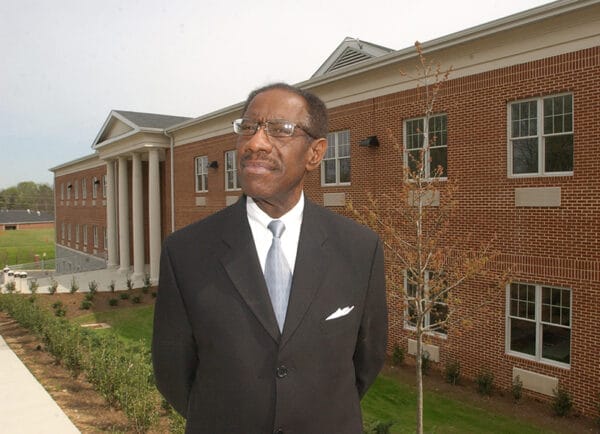 Albert Sloan at Miles College
An expansion of federal financial aid programs enabled Miles College to continue to expand. In 1976, enrollment reached 1,500 students, with more than 80 percent of students receiving aid. In the later 1970s and early 1980s, as the federal government cut aid programs to higher education, Miles College students were adversely affected. By 1986, enrollment had fallen to 500 students. Enrollment, faculty positions, and the endowment continued to drop through early 1989, when Miles College lost its accreditation because of financial problems. After some reorganizing by Pres. Albert J. H. Sloan II (1989-2005), Miles regained its accreditation in 1990. The reorganization led to another period of expansion, and enrollments grew from 438 in 1989 to 1,700 in 2005.
Albert Sloan at Miles College
An expansion of federal financial aid programs enabled Miles College to continue to expand. In 1976, enrollment reached 1,500 students, with more than 80 percent of students receiving aid. In the later 1970s and early 1980s, as the federal government cut aid programs to higher education, Miles College students were adversely affected. By 1986, enrollment had fallen to 500 students. Enrollment, faculty positions, and the endowment continued to drop through early 1989, when Miles College lost its accreditation because of financial problems. After some reorganizing by Pres. Albert J. H. Sloan II (1989-2005), Miles regained its accreditation in 1990. The reorganization led to another period of expansion, and enrollments grew from 438 in 1989 to 1,700 in 2005.
After Sloan’s retirement that year, George T. French became president and oversaw additional fundraising and expansion of the campus. During his tenure, the endowment expanded from $650,000 to $11 million. Much of this success was to the result of an ambitious capital campaign called Determining Our Destiny. Despite a feasibility study that suggested that Miles College could only raise $1.5 million over three years, the college board of trustees approved a $10 million campaign for a five-year period. Set to begin in 1999, it raised $12 million nearly three years ahead of schedule.
The college entered into a new comprehensive fundraising campaign, titled Miles Ahead, in 2008 in order to enhance its curriculum and community partnerships Also, in 2008 Miles College acquired the 41-acre site of the former HealthSouth Metro West hospital, which effectively doubled the current campus. French resigned in 2019 after he was named president of Clark-Atlanta University and was succeeded by the first woman to helm Miles College, Bobbie Knight. An executive with Alabama Power and a long-time member of the college’s board of trustees, Knight has continued to improve the college’s financial and physical standing. In 2020, basketball legend and Alabama native Charles Barkley donated $1 million to Miles College.
The connection to the CME Church remains strong. The faculty and student body represent many religious denominations, and students in their first and second year are required to attend weekly chapel services, known as College Forum, or perform 35 hours of community service and write a research paper to replace the attendance requirement.
 Miles College Golden Bear
Miles views its duty as continuing a long-standing tradition of educating students who otherwise cannot attend college because of their lack of academic preparation, test scores, or funding. This philosophy is best represented by the college’s open admissions policy, which allows any high school graduate to matriculate regardless of standardized test score or grade-point average. The student body consists of approximately 1,700 individuals. Miles College is ranked as the fastest-growing private historically black college in the nation by the United Negro College Fund, on the basis of enrollments, at a time when many smaller colleges have seen declining enrollments. Although it primarily serves residents of Alabama, Miles College draws students from across the United States. The vast majority of students at Miles are of traditional college age, but some 25 percent are over 25 years old.
Miles College Golden Bear
Miles views its duty as continuing a long-standing tradition of educating students who otherwise cannot attend college because of their lack of academic preparation, test scores, or funding. This philosophy is best represented by the college’s open admissions policy, which allows any high school graduate to matriculate regardless of standardized test score or grade-point average. The student body consists of approximately 1,700 individuals. Miles College is ranked as the fastest-growing private historically black college in the nation by the United Negro College Fund, on the basis of enrollments, at a time when many smaller colleges have seen declining enrollments. Although it primarily serves residents of Alabama, Miles College draws students from across the United States. The vast majority of students at Miles are of traditional college age, but some 25 percent are over 25 years old.
With just under 10,000 alumni, Miles College has made a significant impact on the surrounding area and the larger nation. Three Miles College alumni have been elected mayor of Birmingham, including the city’s first African American mayor, Richard Arrington. Additionally, a large number of Miles alumni have become judges, including federal judge U. W. Clemon, as well as physicians, business leaders, legislators, and teachers.
The Miles College mascot is the Golden Bear and the school colors are purple and gold. The college is part of the Southern Intercollegiate Athletic Conference and is part of National Collegiate Athletic Association Division II.
Additional Resources
Miles College Centennial History Committee. Miles College: The First Hundred Years. Mount Pleasant, S.C.: Arcadia Publishing, 2005.
